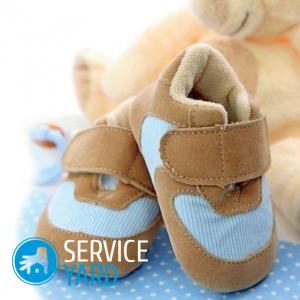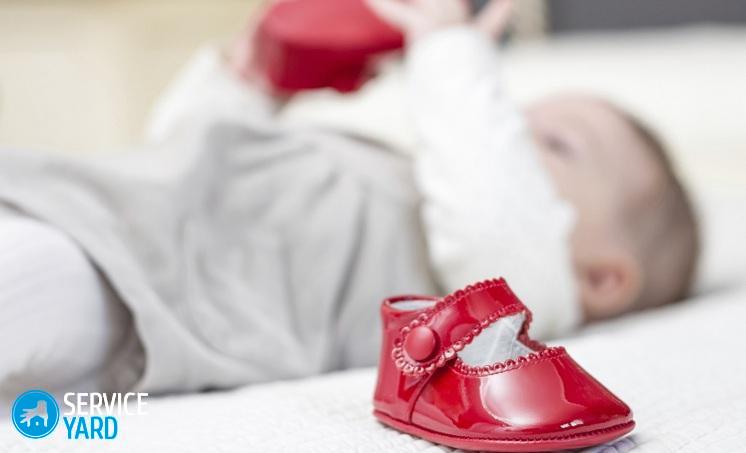The first shoes for the baby - how to choose?

Incorrectly selected shoes for the child can lead to deformation of the foot. The consequences can be very serious and difficult to correct. Before making a choice in favor of a particular pair, it is necessary to study the advice of orthopedists and pediatricians. Let's figure out what the first shoes for the baby are needed, how to choose?
to contents ↑Which shoes to choose?
When choosing shoes for a child, many parents simply try on it on the baby’s leg. But this is not enough, since the sensitivity of the feet in young children is much lower than in adults.
Important! If the new shoe presses, the child may not feel it and not tell the parents. Subsequently, wearing such shoes may be the result of deformation of the feet.
Growth shoes are also not the best option. It’s no longer possible to purchase shoes several sizes, especially for the first steps, because the child needs support in order to firmly and confidently stand on his legs. And in too loose shoes, the legs will get tired too quickly, and the step becomes insecure. In addition, if the shoes or slippers are large, then your child will constantly stumble and fall, and this is fraught with wounds and bumps.
Therefore, in order to correctly determine the size of the child's foot, you need to measure it.
to contents ↑How to measure a children's foot?
- Place the baby's leg on a piece of paper, making sure that the foot is level and firm, and the fingers are not pressed.
- Circle both legs with a pencil from the longest toe to heel. In this case, the pencil must be kept strictly vertical.
- Using a centimeter tape, measure the distance from the extreme point of the heel to the longest finger. This will be the length of the foot.
Important! For kids who still can’t stand confidently, this method will not work. In this case, parents are better off using a soft centimeter tape and measure the child’s foot in a prone position.
Also, when choosing a model, do not forget about the rise and fullness of the foot. These indicators can not be determined using a ruler - only after trying on can you find out whether the chosen shoe model is suitable for the baby.
to contents ↑Important! It is better to choose a model that can be adjusted with Velcro - this way you can fix the leg in a comfortable position. Leave models with laces for the future. In addition, it will be easier for the child to cope with Velcro.
Foot length in centimeters and different mesh sizes
There are several systems by which you can determine the size to choose shoes for a child up to a year:
- Metric - insole length and foot length are equal and are measured in millimeters or centimeters.
- Barcode - the insole length is measured in strokes, each of which is equal to ⅔ one centimeter.
Important! Products manufactured by order of domestic manufacturers in China are marked with a second, bar-mass system.
The sizes of shoes of manufacturers from abroad differ from domestic ones. The main reason is that in Europe and America, foot lengths are measured in inches rather than centimeters.
to contents ↑How fast does a baby's foot grow?
Baby feet grow very fast:
- In the period from 2 to 5 years, every year the child’s foot increases by 2-3 cm.Therefore, doctors recommend measuring the length of the foot once every 3 months in order to timely change the shoes from which the child has already grown.
Important! After 5 years, the growth of the leg slows down a little, and in a year the foot grows by 1 cm. At school age, the size changes by 1-2 per year. In general, it depends on the individual development and heredity of each individual child.
- Girls and boys have differences in foot growth rates. In the first - at the age of 13-14, the leg is often already formed and on average reaches 38 sizes. The second - the 38th size may already be at the age of 10-11 years.
Main selection criteria
There are several nuances to which you should pay attention when choosing shoes for a child up to a year. First of all, the shoe should contribute to the correct formation of the children's foot, as well as the correction of small defects. They are often found in young children and are successfully corrected with the help of massage, exercise and properly selected shoes.
Important! In the manufacture of shoes, manufacturers are guided by hygienic and medical requirements, as well as undergo mandatory certification so that boots, boots or sandals do not cause any harm to the health of children.
What should you pay attention to first of all when buying?
Materials and shape
Shoes should not squeeze a child’s foot. High heels and pointed noses are not allowed here.
Important! It is worth giving preference to natural materials - suede, leather, textiles or nubucku. In such shoes, the foot can “breathe”.
Outsole flexibility
For very young children, the sole will be more flexible than in models for older boys and girls. If the sole is too stiff and difficult to bend, it will be difficult for the baby to walk, it will fall quite often.
Locking back
In high-quality shoes, the back is always quite rigid, due to which the ankle joint is firmly fixed and during walking the child puts the leg correctly.
Small heel
Shoes for children should have a heel, but not too big. The best option would be Thomas's heel, which is always on orthopedic and preventive models.
Depreciation
Children run and jump a lot of time, so you need to pay attention to this parameter. Neglect of this property can lead to joint deformation.
Insole and arch support
The inner insole should be made of breathable materials - textiles, membrane, leather.
Important! The arch support is a small pillow on the insole, which is needed for the prevention of flat feet.
Right size
Children's shoes should be with a small margin. For summer models, the maximum margin can be 1 cm, for winter and demi-season - 1.5 cm.
to contents ↑Stock footage
Thus, when choosing shoes for a child up to a year, it is important that it is well fixed. Prophylactic, orthopedic and therapeutic models should always have a high back and a closed heel. Flexible outsole with cushioning effect protects against joint deformation during running and jumping. And lacing and Velcro will allow you to adjust the shoes to rise and fullness.
- How to choose a vacuum cleaner taking into account the characteristics of the house and coatings?
- What to look for when choosing a water delivery
- How to quickly create comfort at home - tips for housewives
- How to choose the perfect TV - useful tips
- What to look for when choosing blinds
- What should be running shoes?
- What useful things can you buy in a hardware store
- Iphone 11 pro max review
- Than iPhone is better than Android smartphones




